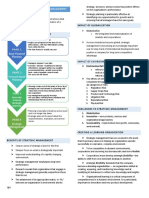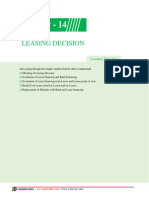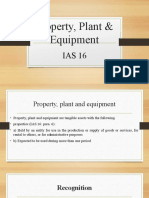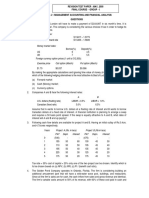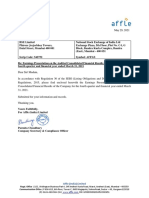Bangladesh Cost Accounting Standards (BCAS)
Uploaded by
Sushanta Kumar RoyBangladesh Cost Accounting Standards (BCAS)
Uploaded by
Sushanta Kumar RoyMarch 05, 2023
Lecture Sheet # 02
Subject: Cost Accounting (COA)_CM121
Topic: BCAS, Cost Concepts & Classifications
Bangladesh Cost Accounting Standards (BCAS):
The Council of the Institute of Cost & Management Accountants of Bangladesh (ICMAB) has
constituted the Bangladesh Cost Accounting Standards Board with the objective of formulating
Cost Accounting Standards.
Till now, the Board has issued 31 cost accounting standards to ensure faithful representation of
cost accounting reports, provide a disciplined approach for maintaining cost accounting records,
ensure uniformity and consistency in cost classification, determination, and assignment of cost to
cost object, provide guidance to the practitioners, user organizations, government bodies,
regulators, research agencies, academic institutions, and others to achieve the objectives of cost
accounting.
The list of Bangladesh Cost Accounting Standards (BCAS) has presented below:
Volume BCAS Nos Name of the Standards Effective Date
BCAS-1 : Cost Concepts & Classifications January 1, 2015
BCAS-2 : Cost Estimation January 1, 2015
Volume-I (Total 10 Standards)
BCAS-3 : Cost Allocation Base January 1, 2015
BCAS-4 : Indirect Costs January 1, 2015
BCAS-5 : Indirect Costs Rate January 1, 2015
BCAS-6 : Support Department Costs January 1, 2015
BCAS-7 : Job-Order Costing January 1, 2015
BCAS-8 : Process Costing January 1, 2015
BCAS-9 : Joint Cost January 1, 2015
BCAS-10 : Target Costing January 1, 2015
BCAS-11 : Life Cycle Costing January 1, 2017
Volume-II (Total 13
BCAS-12 : Kaizen Costing January 1, 2017
Standard)
BCAS-13 : Standard Costing January 1, 2017
BCAS-14 : Activity Based Costing January 1, 2017
BCAS-15 : Product Mix Decisions January 1, 2017
A.B.M. ATAUR RAHMAN ACMA Page 1 of 5
BCAS-16 : Transfer Pricing January 1, 2017
BCAS-17 : Performance Measurement January 1, 2017
BCAS-18 : Cash Flows January 1, 2017
BCAS-19 : Budget and Pro forma Financial Statements January 1, 2017
BCAS-20 : Activity Based Management January 1, 2017
BCAS-21 : Capital Budgeting January 1, 2017
BCAS-22 : Enterprise Resource Planning January 1, 2017
BCAS-23 : Strategic Cost Management January 1, 2017
BCAS-24 : Material Costs December 1, 2019
Volume-III (Total 8 Standards)
BCAS-25 : Employee Costs January 1, 2020
BCAS-26 : Costs of Utilities January 1, 2020
BCAS-27 : Cost of Production for Captive Consumption January 1, 2020
BCAS-28 : Capacity Determination January 1, 2020
BCAS-29 : Cost of Quality January 1, 2020
BCAS-30 : Service Costing January 1, 2020
BCAS-31 : Construction Contract Costing January 1, 2020
BCAS-1: Cost Concepts & Classifications:
Cost: It is a measurement, in monetary terms, of the number of resources utilized for the
production of goods or rendering services. Resources could be: (i) money (ii) efforts; (iii)
materials; (iv) time and utilities consumed; (v) assumed risks; (vi) opportunities foregone in
production and delivery of goods or services.
Cost pool: A cost pool is a subset of total indirect costs that can be associated with a distinct cost
driver. All indirect costs in a single cost pool are similar in a sense that all of them consume
resources with respect to a single cause.
There are three types of cost pools: primary, intermediate, and final. A primary cost pool is the
initial account to which the cost is assigned. An intermediate cost pool is used to accumulate costs
which are pending their final disposition. A final cost pool is the cost pool corresponding to the
cost object. A cost pool that is final for one decision might be intermediate in another decision.
Cost driver: The activities that are undertaken to produce goods or services and that consequently
drive the costs that the costing system records are called cost driver. It drives the cost to incur or
may be the true cause of the cost. For example, mileage driven by an automobile should be a driver
A.B.M. ATAUR RAHMAN ACMA Page 2 of 5
for fuel expenses consumed by the automobile. Cost driver is used as a means of allocating indirect
cost to the respective cost object.
Costs object: A cost object is a segment or an entity for which specific cost information is desired.
This segment or entity may include a contract, any customer, a unit of service, a unit of production,
a project, any activity, a subdivision etc. For a cost object, a separate and independent cost
measurement is required. Costing systems are designed to calculate the cost of a cost object.
Direct Costs: This is a cost that can be easily and conveniently traced to a particular cost object
under consideration. Thus, the cost of a resource that is used only by one cost object is called direct
cost. A direct cost would not exist in the absence of the cost object.
A direct cost may be treated as an indirect cost if it is impractical or expensive to trace such cost
for a specific cost object. For example, office stationery, small tools, etc.
Indirect Costs:
An indirect cost is a cost that cannot be easily and conveniently traced to the particular cost object
under consideration. This type of cost are incurred in joint usage and, therefore, difficult to assign
to or identify with a specific cost object or cost center. Indirect costs are usually constant for a
wide range of output, and are grouped under fixed costs. However, it may be variable also.
In short, indirect cost is any cost that is not directly attributable to a particular cost object.
Some examples of indirect costs are mentioned below:
Rent, ii) Insurance, iii) Depreciation, Property taxes, Repairs & Maintenance, Electricity,
Supervisor’s salary, etc.
Cost Unit: Cost unit represents a unit of product or service for which cost is computed.
Examples of Cost Unit may be Kilowatt (KW) for Electricity cost, kilogram (kg) or liter for raw
material, etc.
Cost Classification:
Cost Classification is the process of segregating the company’s costs into different categories that
gives a fair idea to the decision-maker about the spending pattern. This segregation allows teams
to efficiently use the data for accounting purposes and financial modeling, leading the management
to decide which cost is more important than others.
As per BCAS-1, the Classification of Costs is the process of grouping costs according to their
common characteristics. However, cost classification should be guided by the specific
requirements and nature of the firm. Direct and indirect classification of cost is important for easy
and accurate tracing of cost with cost object.
Cost may be classified from different perspectives under consideration. Some important cost
classifications are mentioned below:
A.B.M. ATAUR RAHMAN ACMA Page 3 of 5
By Nature of Cost: By nature of costs, the cost can be classified as:
a) Manufacturing Cost:
i) Direct Material
ii) Direct Labor Product/Inventoriable Cost
iii) Factory Overhead
b) Non-manufacturing cost:
i) Administrative Expense (H/O)
ii) Selling, Distribution, and Marketing expenses
iii) Finance cost (Non capitalized part) Period Cost
iv) Other non-operating costs
By Element of Costs: By elements of costs, cost can be classified as i) Direct Material, ii) Direct
Labor, and Overhead Costs.
Direct Material Cost: Direct materials are those materials that are consumed during the
manufacture of a product, and which are directly identified with that product.
Direct Labor Cost: This is the cost of wages and other payments made to full-time and part-
time workers that can be easily and conveniently traced to individual units of product. It
includes all payments made to the employees including overtime payments, gratuity,
provident fund (employer’s contribution), leave encashment, and all types of allowances.
Overhead Costs: Overhead costs represents all manufacturing and non-manufacturing
expenses other than Direct Material and Direct Labor. Examples: Indirect materials, Indirect
labor, utility cost, repairs and maintenance, overtime premium, depreciation, insurance, and
all non-manufacturing overhead, etc.
By Product Cost: All manufacturing cost is treated as product cost such as direct material,
direct labor, and factory overhead. All other cost such as Sales & Marketing, Distribution,
and Administration cost is treated as period cost.
By Functions: All costs need to be categorized by departments or functions. Examples:
Production, Sales & Marketing, Distribution, Administration, R&D, etc.
Examples of expenses relating to Production function: Repairs and maintenance cost of
factory premises, depreciation of production machinery, security cost of factory building,
labor welfare costs, canteen expenses, insurance of factory premises, and quality control etc.
Examples of expenses relating to Sales & Marketing function: Salesmen’s salaries,
advertisement costs, sales promotion, cost of gifts used in marketing drive, market Research
cost, and cost of organization of a Sales conference.
Examples of expenses relating to Distribution function: Cost of personnel in the distribution
function, cost of hiring vehicles for distribution of the products, either from the factory to
warehouse or from the warehouse to the end customer, cost of fuel consumed by distribution
vehicles, costs of the outer packing / cartons in which products are packed prior to
distribution, cost of loading / unloading of products, etc.
A.B.M. ATAUR RAHMAN ACMA Page 4 of 5
Examples of expenses relating to Administration function: Salaries of the accounting
department, general office maintenance cost, bank charges, repair, and maintenance of the
administration premises, depreciation of the premises, cost of security of the premises.
Examples of expenses relating to R&D function: All research work connected with a specific
R&D project, all field testing, if any, expenses, salaries of employees involved in the R&D
work.
By Traceability: This classification put focus on the capacity of identification of cost with
the cost object. If scientific identification is possible, the cost will be direct; otherwise, it will
be indirect.
By Behavior or Variability: This definition put focus on the sensitivity of cost in line with
the volume of output. If the amount of cost remains same with a range of output, the cost is
fixed. If the amount of cost varies proportionately, the cost is variable. However, if the
amount of cost is fixed up to certain level (relatively smaller range) and then varies as volume
changes; the cost is semi -variable.
By Controllability: This classification put emphasis on the manageability on part of the cost
controller. If the cost is manageable, the cost will be treated as a controllable cost; otherwise,
it will be treated as an uncontrollable cost.
By Normality: This definition of the cost is based on predictability. If the cost is predictable
with certainty, such cost will be normal; otherwise, it will be abnormal.
By Hierarchy: This classification is based on the causes of costs following a hierarchy. Such as,
i) Unit level Cost: These involve activities performed on each unit produced. ii) Batch level Cost:
These involve activities performed whenever a batch of units is processed. It does not matter how
many units are in a batch, since the activities relate to the presence of a batch, not its size. Machine
setup costs are considered to be at the batch level. iii) Facility-level Cost: These involve activities
carried out for an entire facility. For example, the compensation cost of the materials management
staff is considered to be at the facility level.
By time: Cost can be classified based on time such as historical cost, pre-determined cost,
estimated cost, and standard cost.
By Decision-Making Perspective: Cost can be classified from a decision-making perspective
as follows:
i) Differential cost
ii) Relevant cost
iii) Opportunity cost
iv) Sunk cost.
……………………………………END……………………………………
A.B.M. ATAUR RAHMAN ACMA Page 5 of 5
You might also like
- Basic Questions To Answer-: The Asset Allocation DecisionNo ratings yetBasic Questions To Answer-: The Asset Allocation Decision52 pages
- Chapter - 8: Capital Budgeting DecisionsNo ratings yetChapter - 8: Capital Budgeting Decisions44 pages
- CFA Level II Cheat Sheet: Equity Fixed IncomeNo ratings yetCFA Level II Cheat Sheet: Equity Fixed Income1 page
- Bank Valuation and Value Based Management: Deposit and Loan Pricing, Performance Evaluation, and Risk, 2nd EditionFrom EverandBank Valuation and Value Based Management: Deposit and Loan Pricing, Performance Evaluation, and Risk, 2nd Edition1/5 (1)
- Syllabus FINA 6092 - Advanced Financial ManagementNo ratings yetSyllabus FINA 6092 - Advanced Financial Management5 pages
- NMIMS - SBM: Teaching Plan Financial Management Academic Year: 2016-17 Course Code Course Title Course Instructor/sNo ratings yetNMIMS - SBM: Teaching Plan Financial Management Academic Year: 2016-17 Course Code Course Title Course Instructor/s3 pages
- Security Analysis & Portfolio Management: Risk & ReturnNo ratings yetSecurity Analysis & Portfolio Management: Risk & Return27 pages
- Question 2: Ias 19 Employee Benefits: Page 1 of 2No ratings yetQuestion 2: Ias 19 Employee Benefits: Page 1 of 22 pages
- Balance of Payments:: Chapter Objectives & Lecture Notes FINA 5500100% (1)Balance of Payments:: Chapter Objectives & Lecture Notes FINA 550027 pages
- Valuation of Securities: - Debentures (Bonds) - Preference Shares - Equity SharesNo ratings yetValuation of Securities: - Debentures (Bonds) - Preference Shares - Equity Shares42 pages
- Financial Management: Course: Semester: SPRING 2021 Course ID: FacultyNo ratings yetFinancial Management: Course: Semester: SPRING 2021 Course ID: Faculty3 pages
- Chapter 04 Risk, Return, and The Portfolio Theory100% (1)Chapter 04 Risk, Return, and The Portfolio Theory55 pages
- (BAFI 1045) T01 & T02 (Investments Setting, Asset Allocation, Professional Portfolio Management, Alternative Assets, & Industry Ethics)No ratings yet(BAFI 1045) T01 & T02 (Investments Setting, Asset Allocation, Professional Portfolio Management, Alternative Assets, & Industry Ethics)43 pages
- Question 1: Ifrs 9 - Financial InstrumentsNo ratings yetQuestion 1: Ifrs 9 - Financial Instruments2 pages
- 7891FinalGr1paper2ManagementAccountingandFinancilAnalys PDFNo ratings yet7891FinalGr1paper2ManagementAccountingandFinancilAnalys PDF32 pages
- Investment Analysis and Portfolio Managemnet by Frank K. Relly & Keith C. Brown01 Iapm9e PPT - ch01No ratings yetInvestment Analysis and Portfolio Managemnet by Frank K. Relly & Keith C. Brown01 Iapm9e PPT - ch0134 pages
- Practice Questions On Time Value of MoneyNo ratings yetPractice Questions On Time Value of Money7 pages
- Rules For The Classification Naval Ships Part C - Machinery - Systems and Fire Protection - Chapter 2 A 3 - NR 483.C2 DT R01 E - 2011-11100% (1)Rules For The Classification Naval Ships Part C - Machinery - Systems and Fire Protection - Chapter 2 A 3 - NR 483.C2 DT R01 E - 2011-11118 pages
- Chemsheets AS 006 (Electron Arrangement)No ratings yetChemsheets AS 006 (Electron Arrangement)27 pages
- Koff Gas Turbine Technology Evolution A Designers PerspectiveNo ratings yetKoff Gas Turbine Technology Evolution A Designers Perspective15 pages
- Functional Assessment Interview and Observation100% (1)Functional Assessment Interview and Observation20 pages
- Duchenne Muscular Dystrophy: Marek Michalak, Michal OpasNo ratings yetDuchenne Muscular Dystrophy: Marek Michalak, Michal Opas5 pages
- Norval Morrisseau: Life & Work by Carmen Robertson100% (2)Norval Morrisseau: Life & Work by Carmen Robertson95 pages
- Eriez CrossFlowTeeterBedSeparators BrochureNo ratings yetEriez CrossFlowTeeterBedSeparators Brochure2 pages
- Temperature Excursion Management - A Novel Approac PDF100% (1)Temperature Excursion Management - A Novel Approac PDF8 pages
- The Effect of Workforce Diversity and Organizational Culture On Employee Performance in PakistanNo ratings yetThe Effect of Workforce Diversity and Organizational Culture On Employee Performance in Pakistan20 pages
- Mathematical Learning Performance of Grade 11 Celsius Students in Eastern Visayas Regional Science High School (Evrshs) 2017-2018No ratings yetMathematical Learning Performance of Grade 11 Celsius Students in Eastern Visayas Regional Science High School (Evrshs) 2017-201813 pages
- Chemistry imp ques and Pyqs for 2025 examNo ratings yetChemistry imp ques and Pyqs for 2025 exam30 pages
- Create The Following Tables With The Given Structures and DataNo ratings yetCreate The Following Tables With The Given Structures and Data10 pages
- Clinical Experience With Affinity Pixie™ Oxygenation System in Paediatric and Infant PatientsNo ratings yetClinical Experience With Affinity Pixie™ Oxygenation System in Paediatric and Infant Patients5 pages
- The_Inventory_of_Parent_and_Peer_Attachment_IndiviNo ratings yetThe_Inventory_of_Parent_and_Peer_Attachment_Indivi17 pages
- Basic Questions To Answer-: The Asset Allocation DecisionBasic Questions To Answer-: The Asset Allocation Decision
- Bank Valuation and Value Based Management: Deposit and Loan Pricing, Performance Evaluation, and Risk, 2nd EditionFrom EverandBank Valuation and Value Based Management: Deposit and Loan Pricing, Performance Evaluation, and Risk, 2nd Edition
- Syllabus FINA 6092 - Advanced Financial ManagementSyllabus FINA 6092 - Advanced Financial Management
- NMIMS - SBM: Teaching Plan Financial Management Academic Year: 2016-17 Course Code Course Title Course Instructor/sNMIMS - SBM: Teaching Plan Financial Management Academic Year: 2016-17 Course Code Course Title Course Instructor/s
- Security Analysis & Portfolio Management: Risk & ReturnSecurity Analysis & Portfolio Management: Risk & Return
- Balance of Payments:: Chapter Objectives & Lecture Notes FINA 5500Balance of Payments:: Chapter Objectives & Lecture Notes FINA 5500
- Valuation of Securities: - Debentures (Bonds) - Preference Shares - Equity SharesValuation of Securities: - Debentures (Bonds) - Preference Shares - Equity Shares
- Financial Management: Course: Semester: SPRING 2021 Course ID: FacultyFinancial Management: Course: Semester: SPRING 2021 Course ID: Faculty
- (BAFI 1045) T01 & T02 (Investments Setting, Asset Allocation, Professional Portfolio Management, Alternative Assets, & Industry Ethics)(BAFI 1045) T01 & T02 (Investments Setting, Asset Allocation, Professional Portfolio Management, Alternative Assets, & Industry Ethics)
- 7891FinalGr1paper2ManagementAccountingandFinancilAnalys PDF7891FinalGr1paper2ManagementAccountingandFinancilAnalys PDF
- Investment Analysis and Portfolio Managemnet by Frank K. Relly & Keith C. Brown01 Iapm9e PPT - ch01Investment Analysis and Portfolio Managemnet by Frank K. Relly & Keith C. Brown01 Iapm9e PPT - ch01
- Capital expenditure Complete Self-Assessment GuideFrom EverandCapital expenditure Complete Self-Assessment Guide
- Rules For The Classification Naval Ships Part C - Machinery - Systems and Fire Protection - Chapter 2 A 3 - NR 483.C2 DT R01 E - 2011-11Rules For The Classification Naval Ships Part C - Machinery - Systems and Fire Protection - Chapter 2 A 3 - NR 483.C2 DT R01 E - 2011-11
- Koff Gas Turbine Technology Evolution A Designers PerspectiveKoff Gas Turbine Technology Evolution A Designers Perspective
- Duchenne Muscular Dystrophy: Marek Michalak, Michal OpasDuchenne Muscular Dystrophy: Marek Michalak, Michal Opas
- Norval Morrisseau: Life & Work by Carmen RobertsonNorval Morrisseau: Life & Work by Carmen Robertson
- Temperature Excursion Management - A Novel Approac PDFTemperature Excursion Management - A Novel Approac PDF
- The Effect of Workforce Diversity and Organizational Culture On Employee Performance in PakistanThe Effect of Workforce Diversity and Organizational Culture On Employee Performance in Pakistan
- Mathematical Learning Performance of Grade 11 Celsius Students in Eastern Visayas Regional Science High School (Evrshs) 2017-2018Mathematical Learning Performance of Grade 11 Celsius Students in Eastern Visayas Regional Science High School (Evrshs) 2017-2018
- Create The Following Tables With The Given Structures and DataCreate The Following Tables With The Given Structures and Data
- Clinical Experience With Affinity Pixie™ Oxygenation System in Paediatric and Infant PatientsClinical Experience With Affinity Pixie™ Oxygenation System in Paediatric and Infant Patients
- The_Inventory_of_Parent_and_Peer_Attachment_IndiviThe_Inventory_of_Parent_and_Peer_Attachment_Indivi


































